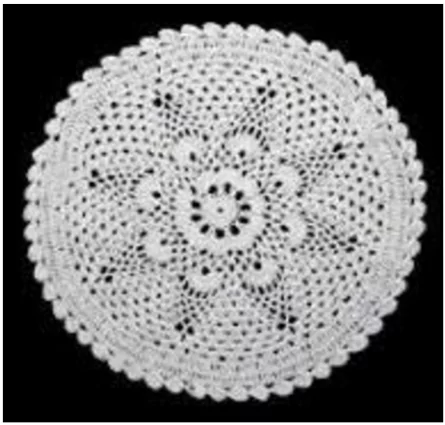GI Tag for Narsapur Crochet Lace
Context: The GI Registry tag certificate for Narsapur crochet lace craft was received by the West Godavari District Collector during the closing ceremony of the GI & Beyond 2024 summit.
- Ministry: The Department of Promotion of Industry and Internal Trade (DPIIT) under the Ministry of Commerce and Industry registered the craft in the Geographical Indications Registry (GIR)
About the Narasapur Crochet Lace Craft

- Origin: The Lace craft was introduced in 1844 by a couple from Scotland as part of their association with a Christian missionary at Dummugudem (presently in Telangana).
- Location: The craft is practiced in the 19 mandals in West Godavari and Dr. B.R.Ambedkar Konaseema districts in the Godavari region of Andhra Pradesh.
- Narsapur and Palacole are the major trade points for lace products in West Godavari district.
- The Craft: The lace work is done using fine cotton threads and these are again woven with thin crochet needles of varying sizes
- Women led Craft:3 categories of products made of lace ie. garments, home furnishings and accessories with nearly 15,000 women directly involved
- An estimated 60% of the artisans involved in the craft are women.
Enroll now for UPSC Online Course
About GI & Beyond 2024 Summit
- The GI and Beyond-2024 Summit is a one day event showcasing the GI handloom and handicraft products across India.
- 10 new GI certificates will be handed over to GI applicants during the inaugural function by Hon’ble Minister for Textiles.
- Organised By: Ministry of Textiles in coordination with Handloom Export Promotion Council (HEPC)
- Objective: The event aims for brand promotion of GI handloom and Handicraft products among the broad spectrum of the stakeholders including overseas buyers, exporters, MNCs, etc.
Reang Tribe
Context: The Tripura government affirmed its commitment to the development of all languages and preventing their extinction, following a request from the Reang community to recognize their oral language, Kaubru.
Reang Community’s Demands
- Recognition of Kaubru Language: The Reang community, one of the 75 Particularly Vulnerable Tribal Groups (PVTGs), requested official recognition for their language, Kaubru.
- Holiday for Hojagiri Day: The community also demanded a holiday on Hojagiri Day, which celebrates their traditional Hojagiri dance, aimed at promoting Tripura’s cultural identity on the global stage.
Government Actions
- The Tripura government established an expert committee for Kaubru language in March 2022, chaired by Dr. Atul Debbarma.
- A new committee led by MLA Pramod Reang was set up in September 2023 to assess Kaubru’s recognition as a separate minority language.
Check Out UPSC CSE Books From PW Store
About Reang tribe
- The Reang tribe, also known as “Bru,” is the second-largest tribal community in Tripura, after the old Tripuri clan.
- They are classified as a Particularly Vulnerable Tribal Group (PVTG) in Tripura.
- Apart from Tripura, members of the Reang tribe are also found in the neighboring states of Mizoram and Assam.
- Historical Background
- The Reang tribe traces its origins to the Shan State in Myanmar (formerly Burma).
- They migrated to the Chittagong Hill Tracts and subsequently to southern Tripura in different waves.
- Ethnicity and Language
- They belong to the Indo-Mongoloid racial stock.
- They speak a language called Kaubru, which is part of the Kok-Borok dialect and belongs to the Tibeto-Burmese linguistic family.
- Social Structure: The Reang community is divided into two major clans, known as Meska and Molsoi.
- Economic Practices: They were traditionally an agricultural tribe, practicing Huk or Jhum cultivation, which is a form of shifting agriculture.
- Religious Beliefs
- Most Reangs in Tripura follow Hinduism.
- They worship a variety of deities, including Buraha, Bonirao, Songragma, Jampira, and Lampra.
- Cultural Contributions
- The Hojagiri Folk Dance is a prominent cultural expression of the Reang tribe.
- This dance has achieved global recognition and serves as a representation of their rich cultural heritage and artistic traditions.
![]() 27 Nov 2024
27 Nov 2024


